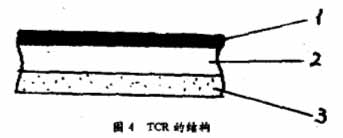The coating of the hot-melt imaging material melts and liquefies and transfers to the plain paper. The coating dye of the dye-sublimation imaging material sublimates and transfers to the plain paper. The two paper or film materials are often cut into strips. Or sheet, commonly known as thermal carbon ribbons, or ribbons (TCR for short).
The substrate for the ribbon may be a capacitor paper having a thickness of 4-6 μm, or a polyester film (PET) having a thickness of 3.5-10 μm. Now the most used are 3.5 and 6μm PET films. Thin substrate heat transfer is fast, it can increase the sensitivity of the transfer material, and has a larger use area.
Ribbon structure, the most common one is: hot melt or sublimation layer / PET / back layer, as shown below:

1, hot melt or sublimation layer. 2, PET substrate. 3, back layer (anti-stick layer)
In order to improve the quality, some ribbons are now added with a layer (special ink composition) for intermittent printing.

Transfer coating and coating:
Take a hot melt, sublimation layer/PET/backing layer structure as an example. According to the different coatings, the coating of the hot-melt layer can be divided into a hot-melt coating method and a solvent coating method. Both of the coatings contain wax, so the hot-melt ribbon is generally called a wax ribbon. The classification is as follows

In addition to the hot-melt coating of the hot-melt layer, the solvent coating, the back layer and the sublimation layer are all solvent-coated, and all use direct gravure roll coating.
The back layer of the dye-sublimation ribbon and the hot-melt ribbon is exactly the same. The anti-sticking agent, the crosslinking agent, and the auxiliary agent are dissolved together in an organic solvent to form an organic solution. The coating weight is only 0.1 μm thick and direct gravure roll coating is used. The back layer has anti-stick properties, which allows the thermal head to run smoothly and smoothly on the back of the PET, and prevents the front and back of the ribbon from sticking when in contact.
1.3 Development of Sublimation Transfer Printers and Consumables and Market Outlook
With the continuous improvement of thermal transfer technology, dye thermal sublimation printing came into being at the beginning of the 1990s. However, due to the high cost of printers and consumables, sublimation printers have not been able to achieve great development in small print shops or home markets.
In recent years, as the demand for personalized output such as digital image kiosk pictures, instant printing cards, and digital photo printing shops has grown, the market has gradually expanded. According to statistics, by 2005, the sales volume of sublimation printers is expected to exceed 10 million units, becoming a force that cannot be ignored in the field of image output. By then, the amount of dye-sublimation printing materials will increase further. According to "Imaging and Communications", the amount of photographic paper for thermal sublimation printing in the world will increase from 12 million m2 in 2001 to 20 million m2 in 2008, with an average annual increase of nearly 10%. In China, sublimation printing consumables have not yet been made domestically. They are in a growing period and are necessary for development.
Currently, manufacturers involved in dye-sublimation printers are increasing in the market. In addition to Kodak, there are Mitsubishi, Canon, Olympus and other manufacturers are constantly introducing new models and special consumables. Printers and consumables products are as follows:

Mianyang Crossing Cross-Border E-Commerce Co., Ltd. , https://www.wycybag.com